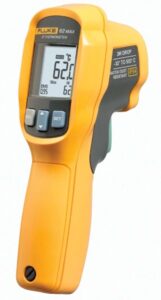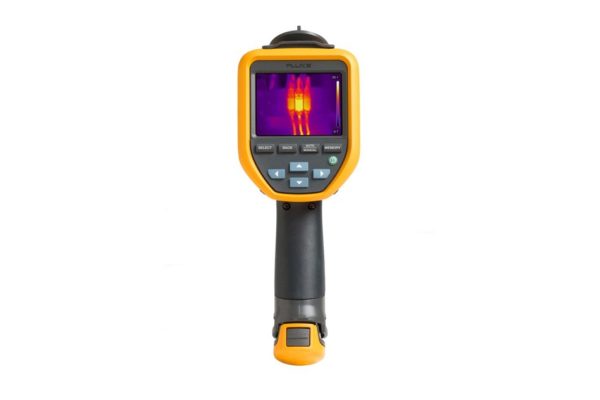Difference Between Infrared Thermometers and Thermal Cameras
Thermal imaging cameras and non-contact infrared (IR) thermometers are both used for non-contact temperature measurements in a wide variety of applications. Both tools work according to the same principle: they detect infrared radiation and translate it into a temperature reading, but that’s where the similarities end.
Infrared Thermometers

Infrared Thermometers also known as spot pyrometer or a temp gun it gives you a single number. It uses a sensor called a thermopile which turns the incoming infrared radiation into heat using tiny thermocouples. The thermocouples convert that heat into an electrical signal which is measured and displayed on the screen in the form of temperature reading. They are used in many industries and work environments to measure the surface temperatures rapidly at a safe distance without having to be in direct contact with the object. They are also called as non-contact thermometers that calculate temperature based on the amount of thermal radiation emitted by the measured object. This is not only ideal for measuring the temperature of difficult to reach areas, but also means that accurate measurements can be taken of moving parts, or of objects in controlled atmosphere.
Thermal Imaging Cameras

While, Thermal imaging cameras capture and create an image of an object using the infrared radiation emitted from the object in a process called thermal imaging. It gives you temperature readings for each pixel the entire thermal image, and allows you to visualize an entire scene in thermal. Thermal cameras are all about converting that infrared light into electric signals and creating an image using that information. Thermal imaging camera uses a focal lane array sensor and has a pixel dimensions of 640 x 480 and each pixel acting as a sensing element that gives you over 300k individual points on each thermal image or video.
Infrared Thermometer can be seen as a thermal camera with only one pixel. Even if a hotspot is too small or faraway to be accurately measured, while a thermal camera may still be able to detect it when scanning over an area, giving the operator a chance to move closer and get more accurate reading and can spot even tiny issue quickly. It can also resolve temperatures from a longer distance, allowing the user to quickly inspect large areas. Infrared Thermometers has the ability to measure temperature on small objects. This capability is increasingly important for electronics inspection. It can also effectively detect and measure temperature, but its spot size may be too large for measuring extremely small components. However, thermal cameras with close-up optics can focus down to less than 5 micrometers per pixel per spot. This allows them to measurement on a very small scale. Infrared thermometers are widely used by different industries such as Automotive, Food, Energy and Medical. It is widely used right now to measure the body temperature for fever of person by a medical profession.
An Infrared thermometer is a great and affordable tool for many applications, especially those at close range when you have a good idea of where exactly you need to measure. However, for distance applications or for scanning a large area quickly, a thermal camera is usually the better tool for the job. The infrared thermometer and thermal imaging seems to be similar but if you further review and research about those tools you will definitely see their huge differences. So running out and buy all the tools today without knowing what are their functions is a waste of time and money.
Our Infrared Thermometers
- Fluke 572 Infrared Thermometer
- Fluke 62 MAX Mini Infrared Thermometer
- Fluke 568 Ex Intrinsically Safe Mini Infrared Thermometer
Our Thermal Imaging Cameras
